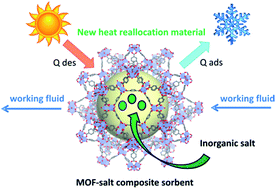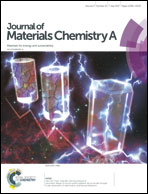Design of salt–metal organic framework composites for seasonal heat storage applications†
Abstract
Porous materials are recognized as very promising materials for water-sorption-based energy storage and transformation. This study presents the first attempt to use Metal Organic Frameworks (MOFs) as host matrices of salts for the preparation of composite sorbents for seasonal heat storage. We have considered six water stable MOFs (i.e. MIL-127(Fe), MIL-100(Fe), MIL-101(Cr), UiO-66(Zr)–NH2, MIL-125(Ti)–NH2 and MIL-160(Al)) differing in their crystalline structure, hydrophilic–hydrophobic balance, pore size/shape and pore volume. The successful encapsulation of CaCl2 in the pores of MOFs leads to two series of MOFs–CaCl2 composites whose salt content could be finely tuned depending on the pore volume of MOFs and the synthesis conditions. These materials were fully characterized by combining multiple techniques (i.e. powder X-ray diffraction, thermogravimetric analysis, scanning electron microscopy, X-ray energy-dispersive spectrometry elemental mapping, N2 sorption and elemental analysis). The water sorption properties of these composites were studied under conditions of a solar heat storage system (i.e. adsorption at 30 °C, desorption at 80 °C, both steps at a water vapour pressure of 12.5 mbar) in comparison to the parent MOFs. We analyze how the physico-chemical and structural properties of these host matrices impact the energy density of composite sorbents. We show that two mesoporous MOFs–CaCl2 composites (i.e. MIL-100(Fe)/CaCl2 and MIL-101(Cr)/CaCl2) with the highest salt loading (46 and 62 wt% respectively) exhibit very high energy storage capacities (up to 310 kW h m−3 (485 W h kg−1)) outperforming the best composites or physical sorbents reported so far together with very little loss upon adsorption–desorption cycling and high chemical stability upon ageing (up to 18 months).

- This article is part of the themed collection: 2017 Journal of Materials Chemistry A HOT Papers


 Please wait while we load your content...
Please wait while we load your content...